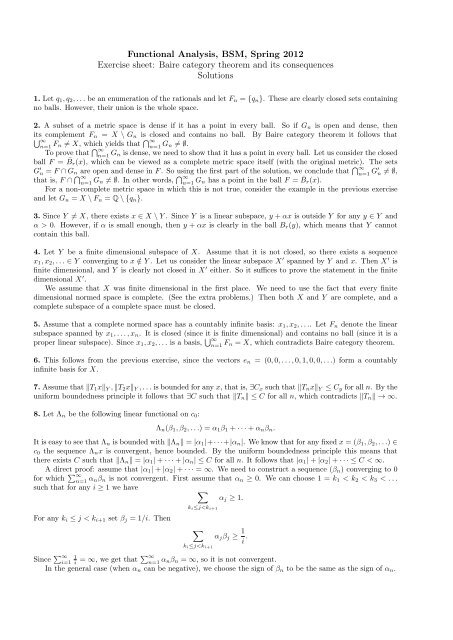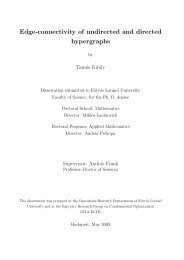Functional Analysis, BSM, Spring 2012 Exercise sheet: Baire ...
Functional Analysis, BSM, Spring 2012 Exercise sheet: Baire ...
Functional Analysis, BSM, Spring 2012 Exercise sheet: Baire ...
Create successful ePaper yourself
Turn your PDF publications into a flip-book with our unique Google optimized e-Paper software.
<strong>Functional</strong> <strong>Analysis</strong>, <strong>BSM</strong>, <strong>Spring</strong> <strong>2012</strong><br />
<strong>Exercise</strong> <strong>sheet</strong>: <strong>Baire</strong> category theorem and its consequences<br />
Solutions<br />
1. Let q1, q2, . . . be an enumeration of the rationals and let Fn = {qn}. These are clearly closed sets containing<br />
no balls. However, their union is the whole space.<br />
2. A subset of a metric space is dense if it has a point in every ball. So if Gn is open and dense, then<br />
its complement Fn = X \ Gn is closed and contains no ball. By <strong>Baire</strong> category theorem it follows that<br />
∞<br />
n=1 Fn = X, which yields that ∞<br />
n=1 Gn = ∅.<br />
To prove that ∞<br />
n=1 Gn is dense, we need to show that it has a point in every ball. Let us consider the closed<br />
ball F = ¯ Br(x), which can be viewed as a complete metric space itself (with the original metric). The sets<br />
G ′ n = F ∩ Gn are open and dense in F . So using the first part of the solution, we conclude that ∞<br />
n=1 G′ n = ∅,<br />
that is, F ∩ ∞ n=1 Gn = ∅. In other words, ∞ n=1 Gn has a point in the ball F = ¯ Br(x).<br />
For a non-complete metric space in which this is not true, consider the example in the previous exercise<br />
and let Gn = X \ Fn = Q \ {qn}.<br />
3. Since Y = X, there exists x ∈ X \ Y . Since Y is a linear subspace, y + αx is outside Y for any y ∈ Y and<br />
α > 0. However, if α is small enough, then y + αx is clearly in the ball Br(y), which means that Y cannot<br />
contain this ball.<br />
4. Let Y be a finite dimensional subspace of X. Assume that it is not closed, so there exists a sequence<br />
x1, x2, . . . ∈ Y converging to x /∈ Y . Let us consider the linear subspace X ′ spanned by Y and x. Then X ′ is<br />
finite dimensional, and Y is clearly not closed in X ′ either. So it suffices to prove the statement in the finite<br />
dimensional X ′ .<br />
We assume that X was finite dimensional in the first place. We need to use the fact that every finite<br />
dimensional normed space is complete. (See the extra problems.) Then both X and Y are complete, and a<br />
complete subspace of a complete space must be closed.<br />
5. Assume that a complete normed space has a countably infinite basis: x1, x2, . . .. Let Fn denote the linear<br />
subspace spanned by x1, . . . , xn. It is closed (since it is finite dimensional) and contains no ball (since it is a<br />
proper linear subspace). Since x1, x2, . . . is a basis, ∞<br />
n=1 Fn = X, which contradicts <strong>Baire</strong> category theorem.<br />
6. This follows from the previous exercise, since the vectors en = (0, 0, . . . , 0, 1, 0, 0, . . .) form a countably<br />
infinite basis for X.<br />
7. Assume that T1xY , T2xY , . . . is bounded for any x, that is, ∃Cx such that TnxY ≤ Cy for all n. By the<br />
uniform boundedness principle it follows that ∃C such that Tn ≤ C for all n, which contradicts Tn → ∞.<br />
8. Let Λn be the following linear functional on c0:<br />
Λn(β1, β2, . . .) = α1β1 + · · · + αnβn.<br />
It is easy to see that Λn is bounded with Λn = |α1|+· · ·+|αn|. We know that for any fixed x = (β1, β2, . . .) ∈<br />
c0 the sequence Λnx is convergent, hence bounded. By the uniform boundedness principle this means that<br />
there exists C such that Λn = |α1| + · · · + |αn| ≤ C for all n. It follows that |α1| + |α2| + · · · ≤ C < ∞.<br />
A direct proof: assume that |α1| + |α2| + · · · = ∞. We need to construct a sequence (βn) converging to 0<br />
for which ∞ n=1 αnβn is not convergent. First assume that αn ≥ 0. We can choose 1 = k1 < k2 < k3 < . . .<br />
such that for any i ≥ 1 we have <br />
αj ≥ 1.<br />
For any ki ≤ j < ki+1 set βj = 1/i. Then<br />
ki≤j
9. Let Λn denote the bounded linear functional f(xn, ·) : Y → R, that is, Λny = f(xn, y). For a fixed y, the<br />
linear functional f(·, y) : X → R is bounded, that is, there exists Cy such that<br />
|f(x, y)| ≤ Cyx.<br />
Since xn → 0, there exists M such that xn ≤ M for all n. It follows that<br />
|Λny| = |f(xn, y)| ≤ Cyxn ≤ M · Cy.<br />
Thus the uniform boundedness principle yields that there exists C such that Λn ≤ C for all n. So<br />
10. Consider the identity map on X:<br />
|f(xn, yn)| = |Λnyn| ≤ Λnyn ≤ Cyn → 0 as n → ∞.<br />
T (x) = x for x ∈ X.<br />
We can view this map as a linear operator from (X, · 1) to (X, · 2). Since x2 ≤ Cx1, we have<br />
T 1,2 ≤ C < ∞. So T is a bounded operator; it is clearly bijective, so by the inverse mapping theorem<br />
T −1 = T as an (X, · 1) → (X, · 2) operator is also bounded. With D = T −1 2,1 we get the desired<br />
inequality x1 ≤ Dx2.<br />
11. Consider the vector space ℓ1 with the ℓ1 and the ℓ∞ norms. For any x ∈ ℓ1 it clearly holds that x∞ ≤ x1.<br />
However, for xn = (1, 1, . . . , 1, 0, 0, . . .) ∈ ℓ1 we have x∞ = 1, but x1 = n.<br />
12. We will apply the uniform boundedness principle to the dual space X ∗ . The role of Tn will be played by<br />
ˆxn ∈ X ∗∗ . Recall that ˆxn is defined as the bounded linear functional on X ∗ for which ˆxnΛ = Λxn (Λ ∈ X ∗ ).<br />
The assumption that (Λxn) is bounded means that for any vector Λ in our space X ∗ the sequence ˆxnΛ is<br />
bounded. Using the uniform boundedness principle we get that there exists C such that ˆxn ≤ C for all n.<br />
However, we proved that xn = ˆxn, we are done. (Note that we did not use the completeness of X. We<br />
needed that the dual space X ∗ is complete, which is true even if X is not.)
















